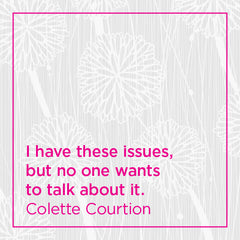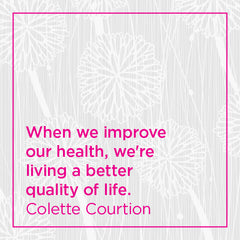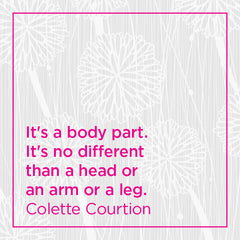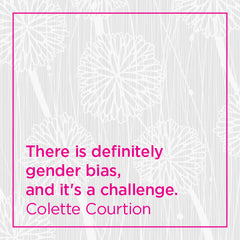 Educated in economics, accounting, and finance, Colette Courtion found her way to bioscience and technology. She identifies herself as a femtech innovator and an entrepreneur, and is the founder of Joylux, Inc., a consumer health-tech company. When she began her journey of motherhood, her friends shared changes from giving birth and aging that no one likes to talk about. With few treatment options available in women's intimate health, Colette found that most women just suffer in silence. Building on her experience in medical aesthetics working with innovative technologies, she partnered with a team of OB/GYNs and luminaries in the field of laser/light science to create revolutionary products for intimate health. (Also, she loves to dance.)
Educated in economics, accounting, and finance, Colette Courtion found her way to bioscience and technology. She identifies herself as a femtech innovator and an entrepreneur, and is the founder of Joylux, Inc., a consumer health-tech company. When she began her journey of motherhood, her friends shared changes from giving birth and aging that no one likes to talk about. With few treatment options available in women's intimate health, Colette found that most women just suffer in silence. Building on her experience in medical aesthetics working with innovative technologies, she partnered with a team of OB/GYNs and luminaries in the field of laser/light science to create revolutionary products for intimate health. (Also, she loves to dance.)
This post contains affiliate links. If you make a purchase after following one of the links, MiddlesexMD may receive a commission.
Dr. Barb: While I spend most of my time at medical conferences in dark rooms listening to presenters with lots of PowerPoint slides, I can also explore new products and services in the exhibit hall. And that's where at the North American Menopause Society September annual meeting, I met a woman from Joylux. She told me about the company and the products they offered. I was interested enough to track down the woman who founded the company, Colette Courtion, and she's my guest today. Welcome, Colette.
Colette: Thank you, Barb. I'm delighted to be here and to share the story of what we're doing at Joylux.
Dr. Barb: Good. So I've read that you were a lead in the cosmetic device company, and then you and quote, "Had a rude awakening about the pelvic floor." So tell us a little bit about kind of where you've been and how you've come to where you are today.
Colette: Wonderful. I just love sharing this story. My background is, I've spent the last 15 years of my career working in medical aesthetics. So I was working with all the latest technologies to help improve a woman's facial, anti-aging, rejuvenation of the facial tissue. And when I decided to become a mother, it was later in life and most of my girlfriends had had their children and I said, "It's time for me to become a mom." And they said, "Okay, Colette, but be prepared because every time you sneeze or laugh or jump up and down, you're going to pee your pants." And I was mortified to learn about this because I assumed that pregnancy and childbearing was all about just weight gain and you struggled to get the weight off. I had no idea that we deal with things like bladder leakage.
 And so I looked into it and discovered that women really suffer from this problem. It's quite pervasive. They also deal with a whole host of other vaginal health issues, especially as they go through menopause, such as dryness, pain with intercourse, and a whole host of other things. And I just couldn't believe it. And I literally had what I call my "aha moment" where I said, "Why are we not using these advanced technologies that we use on facial tissue to help tone and tighten and restore, but use it on the vaginal tissue area?" And that's when I shifted my 15 years of aesthetic experience by partnering with a really great OB/GYN and a scientist. And together the three of us created what has now become the world's first and only home use device that uses light technology to restore the vaginal tissue.
And so I looked into it and discovered that women really suffer from this problem. It's quite pervasive. They also deal with a whole host of other vaginal health issues, especially as they go through menopause, such as dryness, pain with intercourse, and a whole host of other things. And I just couldn't believe it. And I literally had what I call my "aha moment" where I said, "Why are we not using these advanced technologies that we use on facial tissue to help tone and tighten and restore, but use it on the vaginal tissue area?" And that's when I shifted my 15 years of aesthetic experience by partnering with a really great OB/GYN and a scientist. And together the three of us created what has now become the world's first and only home use device that uses light technology to restore the vaginal tissue.
And what I love about what I do is, of course, I'm not a medical professional, so I've surrounded myself with really bright doctors. But what I love about it is that we are really truly making a difference in women's lives. We're helping women regain their confidence and their intimacy by restoring what is such an important function of being a woman.
Dr. Barb: Well, congratulations on your accomplishment. And I just think it's so inspiring to think that you recognized a need and decided to conquer it. And so I think on behalf of so many women, thank you for taking the courage. I know that it's no small thing to step out and try to create something new and bring it to market. And here you are. So tell us more about the actual technology as to how this device benefits women and pelvic floor and what really goes on that creates the improved function for women?
Colette: Great question. So as we age and as we go through childbirth, our tissue becomes compromised. Either it tears because of delivering or the weight of carrying a child or with menopause, with the decline in estrogen, our cells, our tissue, it just doesn't function as it once did. A great example is if you look at our faces, notice why we get wrinkles as we age, it's because we don't produce the collagen and elastin in our tissue like we did when we were young. Same thing is happening to our vaginal tissue. It is losing that collagen and elastin, it's losing that blood flow and blood flow is such an important thing to keep our cells healthy and vibrant. And so what we discovered is that when we take light, and light in a specific color, it's red. When we apply light energy to our tissue, the mitochondria in our cells and the mitochondria are the power horses.
They are the things in our cells that produce energy and when our cells produce energy, it gives us, allows our bodies to function internally so that we can do the things externally that we want. So this light excites the mitochondria in our cells to produce the things that we need, the collagen, the elastin, the blood flow. And so in real simple terms, I like to say that light energy is like a battery energizer. It's restarting the battery of our cells. It's getting our cells to do what they're supposed to do. And by doing that, it's really restoring the health of our cells, the function of our cells.
So by doing that, things like blood flow, it increases the blood flow, which helps things like natural lubrication, with incontinence or bladder leakage. It's increasing the production of collagen, elastin, which tightens the tissue around our pelvic floor area. So our vaginal tissue has tightened our urethra sphincter. That is tightened. And when all of that is back to a healthy, tightened state, we have more control over our leakage. And so when we're jumping up and down or when we're sneezing, it no longer... We have control and so we no longer leak. So what we're discovering with our technology, it really is restoring the health of the tissue in the pelvic floor region. So our body functions like it was supposed to before we went through life's major milestones, like childbirth and aging.
Dr. Barb: That was a really great translation, I think, for the general public to better understand some of the complicated science and technology that goes into improving those tissues. So thanks for making that really understandable.
 Colette: It's Latin to most people, including me. And so the way I look at it is at the end of the day, the technology is working and we don't really need to, as a consumer, as a patient, we don't really need to understand that the science behind it. But what we need to know is that at the end of the day, it's improving our health. And when we're improving our health, we are living a better quality of life. We are living more... We're being more active. We're connecting more with our partners. It's improving that quality of life, which makes us who we are as women. And that's really what's so motivating and empowering and important to me at the end of the day as a CEO of this company.
Colette: It's Latin to most people, including me. And so the way I look at it is at the end of the day, the technology is working and we don't really need to, as a consumer, as a patient, we don't really need to understand that the science behind it. But what we need to know is that at the end of the day, it's improving our health. And when we're improving our health, we are living a better quality of life. We are living more... We're being more active. We're connecting more with our partners. It's improving that quality of life, which makes us who we are as women. And that's really what's so motivating and empowering and important to me at the end of the day as a CEO of this company.

Dr. Barb: The product that I saw when I was at the meeting in Chicago was your vFit. Unfortunately we're only audio. We're not a visual, so we don't have the visual of, it's really a beautiful device. But I'm wondering if you could describe it just a little bit for the listeners and then more specifically how an individual uses it to get the benefit. What the actual day to day use would be to achieve and maintain the outcomes?
Colette: That's a great question. Yes. So we have two products. Our first product is vSculpt. That's not yet available in the United States, so that's sold around the world. And then we have our vFit product, which is sold in the United States and both use the red light energy, that technology that I was talking about. The one here in the United States, vFit, it's a beautiful design. I like to call it, it's the Apple product for vaginas. [laughs] very clean, white look. It's like the original Apple products. It is a device that you have to insert into your vagina and people say, "Well, I'm apprehensive of doing that." But really for us to get the benefit that we need, we have to treat from within. And so that's why that's an important thing on that it is inserted in the vagina.
It's quite comfortable. So when the red light is turned on, the light generates a warm heat that feels very, very pleasant. And then the device also has Sonic technology, which is like a vibration, not to be confused with a vibrator. This is not a vibrator in the the sense of how we think of vibrators, but it does emit a sonic vibration, which is really helpful in stimulating the muscle tissue. But also it acts in amplifying the light energy and we've done lots of studies around this, so it's an important part of the overall technology. So when you get the product and you use it for the first time, you insert it, and the very first time you're just going to use it for six minutes and the device will automatically turn off. So you turn it on, you select the six minute treatment time, and then it automatically turns off.
Then the next day you don't do the treatment. But then the second day or the third day, we're going to have you use it again. And this time you go to eight minutes and you're going to build up every other day till you get to 10 or 12 minutes. And at that point, once you're at 10 or 12 minutes, you use it for six weeks every other day and that's when women report back. They're seeing an improvement in their intimate health, their overall intimate wellness.
After they've achieved the desired outcomes with whatever reason they were buying the product for, because we addressed so many wonderful health issues. Once they've achieved their desired outcome, then they go into what we call the maintenance mode where they only have to use it once a week for 10 minutes. And again, it's a really easy passive session. Most women will sit back, read a book, watch television. Ten minutes goes by so quickly and again, the device is comfortable, it doesn't hurt, doesn't emit any electricity or some other devices out there have TENS devices that will have this little spark. Ours is very comfortable and very pleasant to use.
Dr. Barb: So there have been some technologies, not exactly like this, but somewhat like this, that have been installed in physician's offices for women to come in for their treatments. But this is really, as you mentioned in the onset of our discussion together, that this is really the first therapeutic technology that women can bring into their homes. So what was your motivation or was that always your primary motivation that women could do this at home?
Colette: Absolutely, because we are busy women and this is a very private nature. And I don't know about you. Well, I guess, you being the doctor, you're used to this. But the last thing I want to do is go to my gynecologist and have someone poking and prodding me down there.
Dr. Barb: I appreciate that. Yes.
Colette: So for me it was important that the woman being able to treat herself at home and because it is a quick treatment, it's only 10 minutes, you don't have to take the time to go to the physician's office to wait in the waiting room, park your car, wait in the waiting room, have your treatment and leave. You can just do it when it's on your time in the comfort and privacy of your home, but have the same clinical efficacy that you would get if you had done it in a doctor's office. So that's where we spent years and years of research making sure that our technology really works as if you were doing it in a physician's office, but you can do it at home.
Dr. Barb: So you talked about the women who might benefit from this, primarily around urinary incontinence and maybe vaginal dryness or painful intercourse from atrophy and menopause. Are there other women who might be a target for benefiting from the product?
Colette: Well, our product here in the United States is really geared towards women wanting to improve their overall intimate health and wellness and so that can mean a lot of things to a lot of women. From a regulatory standpoint, that's what we are cleared for, so it's for the improved movement of women's intimate health. You as a doctor can certainly talk more about the benefits and I would love to make sure you have a device and that you use it or have one of your listeners or one of your patients use it so that you could report back on what you're seeing because all I can say is that this truly is making a positive impact in so many women's lives and I'm just so encouraged by what we are hearing from the women who are using it.
Dr. Barb: That's exciting. I think this is really a wonderful breakthrough technology for women to, as you said, be able to do this in the privacy of their own home because the limitation of a busy practice, the cost of doing things in an office, just the loss of your privacy and choosing to do this by needing to go to a physician's office, that's a huge hurdle for women to get beyond, to be accepting of some of these therapies. So I think that's going to... the genius behind this is to make it available for women to do at their own convenience.
Colette: Yes. And I just am so thrilled to see how many women are embracing this, our technology and are prioritizing their intimate health. I was recently on a television show in Canada, and this was the first time a national television show had even brought up the topic of vaginas and intercourse and all the things that women deal with. And so for me, I was just so proud that they decided to tackle this topic, but we literally, the response was so positive because women were saying, "I have these issues, but no one wants to talk about it and I'm so thrilled that you're embracing the conversation because it is so important and vital to who we are as women."
Dr. Barb: We've certainly run across that in trying to promote my website, MiddlesexMD, and some of the discussions around sexual health. It's really hard on some platforms to get that message out because some of the language used is shockingly not seen as acceptable language for some of the media. On the other hand, there's so much awful things that can be communicated.
 Colette: I know. It's such a double standard. We face this challenge every day when we're advertising or promoting our product on Facebook and some of the other social platforms, the word vagina is banned. We're not allowed to say that. It's viewed as pornographic, but to me it's a body part. It's no different than a head or an arm or a leg. It's who we are as women. It's what God gave us. And so it's frustrating to me that we can't even talk about it and normalize the terminology, whereas erectile dysfunction and penises, that's talked about every single day. I can't turn on the TV without seeing an ad for erectile dysfunction, but yet we women don't have the same platform, the same ability to talk about our issues and that to me is just wrong. And we're fighting that battle every day and we're trying to raise awareness with these companies.
Colette: I know. It's such a double standard. We face this challenge every day when we're advertising or promoting our product on Facebook and some of the other social platforms, the word vagina is banned. We're not allowed to say that. It's viewed as pornographic, but to me it's a body part. It's no different than a head or an arm or a leg. It's who we are as women. It's what God gave us. And so it's frustrating to me that we can't even talk about it and normalize the terminology, whereas erectile dysfunction and penises, that's talked about every single day. I can't turn on the TV without seeing an ad for erectile dysfunction, but yet we women don't have the same platform, the same ability to talk about our issues and that to me is just wrong. And we're fighting that battle every day and we're trying to raise awareness with these companies.
Like Facebook, we're saying, "Hey guys, this again is no different from what men are dealing with and have the ability to speak about." Unfortunately, what we're seeing is a lot of these companies are still run by men and they just don't understand it and they just think of it is, oh, this is taboo. We can't talk about it. So we're here today to break down those barriers, but it's challenging for sure.
Dr. Barb: It is challenging, although I do feel like we're making some progress and there is some increased traction around bringing these conversations to the forefront. So thanks for being one of those women who's championing that and about your referencing men in this space. So what's been your experience as a woman leading a medical technology company?
 Colette: Well, I am fortunate that we've surrounded ourselves on whether it was investors or team members or advisors that just are absolutely thrilled with what we're doing because if there are men and they personally don't deal with the issues, they have a wife or a sister or a mother that may have, so they totally understand how it can impact the overall quality of a woman's life. So I'm just thrilled first and foremost, that we have surrounded ourselves with a great group of people. Having said that, there are definite challenges being a woman in the medical device world in this space, and there is bias. When I go to an investment meeting or even work with the FDA, there is definitely gender bias and it's a challenge. Having said that, again, there are a lot of wonderful people out there, men out there who are hundred percent behind what we're doing and see how important it is to promote women's health and specifically women's intimate health.
Colette: Well, I am fortunate that we've surrounded ourselves on whether it was investors or team members or advisors that just are absolutely thrilled with what we're doing because if there are men and they personally don't deal with the issues, they have a wife or a sister or a mother that may have, so they totally understand how it can impact the overall quality of a woman's life. So I'm just thrilled first and foremost, that we have surrounded ourselves with a great group of people. Having said that, there are definite challenges being a woman in the medical device world in this space, and there is bias. When I go to an investment meeting or even work with the FDA, there is definitely gender bias and it's a challenge. Having said that, again, there are a lot of wonderful people out there, men out there who are hundred percent behind what we're doing and see how important it is to promote women's health and specifically women's intimate health.
Dr. Barb: So what feeds you as an innovator?
Colette: Making a difference in women's lives. I am just... The stories we get from women that have used our products and how it's given them such a positive new outlook and how it's allowed them to re-engage, whether it's activities or re-engage with their partners. I love hearing these stories. I wish women were more open than they are, but we do get the stories because the women trust us and it's just so motivating. I love to know I'm making a difference in this world one vagina at a time.
Dr. Barb: Yeah, it is rewarding isn't it? I think I have a sense of it from a different aspect, but I would share your enthusiasm for helping achieve successes for women and their partners. And I want to thank you for your time today and as we conclude our time, I'd like to know if you'd be willing to share, where do you find fullness at this stage of your life?
Colette: Well, I'm blessed with, I did have a child, so this whole journey began with me wanting a child and I did end up getting pregnant and I have a beautiful boy who is soon to be five and he's really the inspiration behind this company. And when I leave the office, I go home to this darling, darling little kid that definitely keeps me very, very full and motivated every day to keep doing what we're doing, and because he is the inspiration and the joy in my life.
Dr. Barb: I can hear the joy in your voice as you speak about him.
Colette: Thank you.
Dr. Barb: So I congratulate you on your journey in motherhood and hopefully it will be very rewarding. So thanks for your time again, Colette.
Colette: Yeah, Barb, I just wanted to make sure that your viewers know where to get the vFit product. I'm hopeful that you'll soon be offering it.
Dr. Barb: Yes.
Colette: If anybody has any questions about what we're doing, please go to getvfit.com, where you'll have all the information about our product and who we are as a company and the difference that we are trying to make in women's lives.
Dr. Barb: Yeah, I would encourage you to visit that and just again to see the product and get some sense of what we're talking about. Because I think it's a little hard for women to visualize what this might look like. But it is such a lovely product and I think not intimidating and I think easy to use. You know, I held it and it was demonstrated to me at the meeting, and I think it's really, as you mentioned, it's the Apple product for the vagina. So, way to go, Colette.
Colette: There you go.
Dr. Barb: Thanks again.
 Dr. Barb DePree, M.D., has been a gynecologist and women’s health provider for almost 30 years and a menopause care specialist for the past ten.
Dr. Barb DePree, M.D., has been a gynecologist and women’s health provider for almost 30 years and a menopause care specialist for the past ten.


6 comments
Peninah, you can find information about shipping to locations outside the US on this website: https://vsculpt.com/
Thank you so much for what you are doing to women.
I am in Kenya, how can I get the vFit product?
Tammy, we invite you to explore the website. We have many articles and products you may find helpful. If you have specific questions we can answer please use this link: https://middlesexmd.com/pages/contact-us
Interested in more information
Thank you,
Tammy
I have seen results from the vFit product in patients who use it to address vaginal dryness. Like each state for each of the prescription products, this too has about an 80% response rate for beneficial results. It is not 100% in 100% of patients. We’re excited to have this non-prescription option to offer women who haven’t had a successful result from prescription therapies, or who prefer not to use them, or who it is recommended they not use them (breast cancer patients). While it is expensive, the co-pays for prescriptions are often expensive and they are on-going for the duration of use of the prescription medication, while this is a single ‘up front’ cost, most women are seeing this as a reasonable investment.